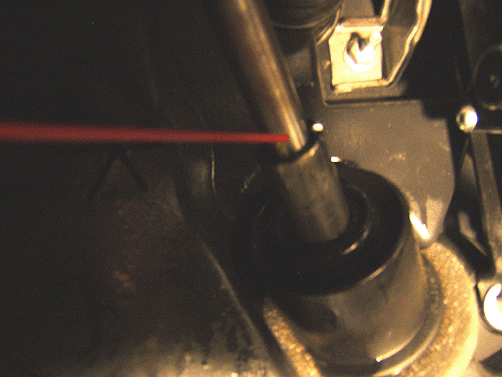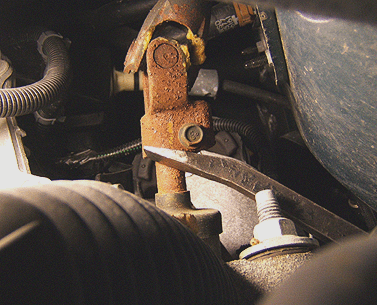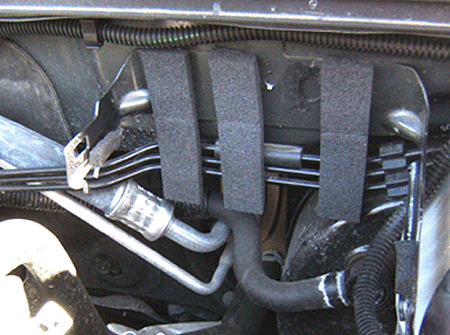Clunk/Knock/Rattle From Front of Vehicle When Driving/Turning over Bumps (Diagnose Noise - Lubricate Inner/Outer Steering Shaft, Reposition I-Shaft, Add Foam to Radiator Surge Tank Mounting Bracket)

| Subject: | Clunk, Knock or Rattle Noise From Front of Vehicle While Driving or Turning Over Bumps at Low Speeds (Diagnose Noise - Lubricate Inner and Outer Steering Shaft, Reposition I-Shaft, Add Foam to Radiator Surge Tank Mounting Bracket and/or Replace Steering Gear, If Necessary) |
| Models: | 2004-2007 Chevrolet Malibu/Maxx |
| 2005-2007 Pontiac G6 |
| with Electronic Power Steering (EPS) |
This bulletin is being revised to update the model years, include more conditions and additional information and update the warranty information. Please discard Corporate Bulletin Number 06-02-32-007A (Section 02 -- Steering).
Condition 1
Some customers may comment on a clunk noise heard and felt in the steering wheel while driving at slow speeds and turning. The clunk noise may appear to be directly in front of the driver. Hitting a bump while turning can produce the clunk noise. Sometimes the noise may be duplicated when the vehicle is sitting still and the steering wheel is turned 90 degrees in either direction before initially centering the steering wheel.
Cause 1
The clunk noise may be caused by the lack of lubrication between the inner and outer steering shafts.
Correction 1
Important: DO NOT disconnect the intermediate shaft to lubricate.
Lubricate the intermediate shaft with GM Superlube using the procedure below:
- From inside the vehicle, spray GM Superlube, P/N 12346241 (in Canada, use P/N 10953474), into the gap between the inner shaft and outer shaft at the steering shaft for about two to three seconds.
- Start the vehicle and turn the steering wheel 180 degrees and spray into the gap between the inner shaft and the outer shaft again for about two to three seconds.
- Wipe off any excessive lubricant that may run down the outer shaft with a shop towel.
- Cycle the steering wheel lock to lock for two complete cycles.
- Verify that the clunk noise is no longer present.
- If the clunk noise is still present, raise and suitably support the vehicle. Refer to Lifting and Jacking the Vehicle in SI.
- Check the position of the intermediate shaft as it connects to the steering gear. There may be an interference condition between the clamp and the steering gear input shaft. The clamp is beveled and if forced down on the input shaft too hard, it may cause a loose fit with the intermediate shaft to input shaft joint. To correct this condition, perform the following steps:

| 7.1. | Loosen the intermediate shaft pinch bolt at the steering gear end. |

| 7.2. | Pry the clamp up using a pry bar to position the bolt into the upper part of the groove as shown above. This will position the clamp off of the bevel. |
| 7.3. | While keeping the clamp in the upper position, tighten the bolt. |
Tighten
Tighten the bolt to 49 N·m(36 lb ft).
| 7.4. | Verify that the clunk noise is no longer present. |
Condition 2
Some customers may comment on a knocking or rattling type noise from the front of the vehicle when driven at low speeds and over bumps. The noise only occurs when the steering wheel is in the straight ahead position and sounds like the noise is in the left suspension of the vehicle or directly in front of the driver.
Correction 2
- Determine the source of the noise. Install the chassis ears at the following locations:
- If the noise is coming from the upper strut mount or sway bar link, replace as necessary and retest.
- For 2004-2006 model year vehicles, the noise may be coming from the radiator surge tank area. (The 2007 model year vehicles use a different style radiator surge tank - refer to Step 9.)
- If the noise is coming from the radiator surge tank, release the two retaining tabs holding the radiator surge tank and reposition the tank away from the attaching bracket and isolate with closed cell foam.
- Cut three pieces of closed cell foam, P/N P46515 (or equivalent), into 25 mm (1 in) by 102 mm (4 in) pieces.
- Cut two pieces of closed cell foam into 25 mm (1 in) by 6 mm (¼ in) pieces.
- Install the three pieces of foam to the attaching bracket starting at the top center inside the bracket and proceed down across the fuel lines, then at the inside of the bracket at the left and right positions of the center piece of foam. Finally, install the last two pieces of foam to the inside bracket at the left and right extended sides behind the retaining holes as shown above.
- Reposition the radiator surge tank back onto the bracket and seat the two retaining tabs on the tank.
- Drive the vehicle to verify that the noise is no longer present.
- If the intermediate shaft position was correct, the I-shaft was lubricated, and the closed cell foam was added to the radiator surge tank bracket for 2004-2006 model year vehicles, then the noise the customer is hearing is from the rack gear and pinion gear contact internally in the steering gear. The steering gear should be replaced with the new part number gear listed below. Refer to the Power Steering Gear (EPS) Replacement procedure in SI.
| • | sway bar link, one side at a time |
| • | upper strut mount, one side at a time |
| • | steering gear near the pinion area |
| • | base of the steering column housing |
| • | radiator surge tank |

Parts Information
Order Adhesive Back Shim Stock from Kent Automotive at 1-888-YES-KENT or online at www.kent-automotive.com.
Part Number | Description | Material Allowance |
|---|---|---|
P46515 | Adhesive Back Shim Stock (25 mm x 30 ft roll) [15 mm (9/16 in) thickness] | $1.60 per vehicle ($1.78 in Canada) |
Part Number | Description |
|---|---|
15858368 (Base Gear) | Steering Gear Assembly |
15858369 (Restricted Travel Gear) (Vehicles with 17" Wheels) | Steering Gear Assembly |
Warranty Information
For vehicles repaired under warranty, use:
Labor Operation | Description | Labor Time |
|---|---|---|
E9448* | Lubricate and Reposition I-Shaft to Correct Noise | 0.3 hr |
Add | Install Foam (2004-2006) | 0.1 hr |
* This is a unique labor operation for bulletin use only. It will not be published in the Labor Time Guide. For other repairs, submit the appropriate published labor operation. | ||
